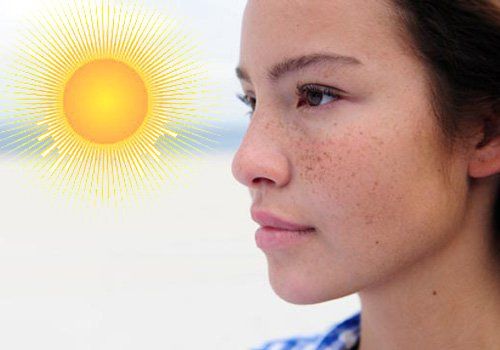This is an automatically translated article.
In sunlight, there are 3 regions of light, which are infrared light (also known as thermal light), ultraviolet light (also known as ultraviolet light) and white light. If exposed for a long time, the impact of the sun on the skin can cause a number of skin diseases such as allergies, dermatitis, sunburn, ...
1. What areas of sunlight are there in sunlight?
In sunlight there are 3 different light regions, which are white light, ultraviolet and infrared light.
Depending on the following factors, the degree of light sensitivity of each person is different:
Skin color. Age (light sensitivity of children, adults and the elderly is 5%, 100% and 65%, respectively). Minimum light induction dose. Time, season (in a year, the light of spring and summer affects the skin the most).

Ánh nắng mặt trời là nguyên nhân gây ra nhiều bệnh lý về da
2. What disease can the sun's effects on the skin cause?
Exposure to the sun for a long time without protection or cover can damage the skin and cause some skin diseases such as dermatitis, allergies, sunburn, ...
2.1. Inflammation of the skin caused by the sun
Sunburn is the common name for photodermatitis, which is damage to the skin caused by direct exposure to an excessive amount of sunlight and ultraviolet rays that exceed the amount of melanin pigment to protect. skin of the body.
Photodermatitis can appear on both skin areas with or without direct exposure to the sun. Common sunburn sites are on the upper extremities and open areas of skin. In the sun, the causative agent of dermatitis is usually chemicals that are used either systemically or topically.
Photodermatitis has 2 main clinical forms: lawn dermatitis (common in people lying in the sun, exposed to ultraviolet rays for a long time, using systemic or topical chemicals, or using a foods such as carrots, celery, angelica, figs) and ring-pigmented dermatitis (common after using perfume, the location of appearance is on the sides of the neck).
Sunburn is common in many people with the basic clinical manifestations in the damaged skin area:
Red, burning Appearance of erythema Eczema, edema After a period of dry skin, peeling scabs and leaving dark spots skin .

Viêm da do ánh nắng có thể phát triển thành sạm da
2.2. Sun allergy
Sun allergy is also a skin condition similar to solar dermatitis (sunburn), but the disease usually appears more slowly (after 24 hours of exposure to sunlight, ultraviolet rays) and difficult to detect. more, because the lesions initially only appear in the open skin, then spread to the whole body.
The causative agent of sun allergy is similar to dermatitis, it is caused by systemic or topical use of the following drugs, chemicals and cosmetics:
Drugs: topical analgesics, antihistamines, chlorpromazine. Sunscreen containing Aminobenzoique. However, the clinical manifestations in the affected area are similar to acute eczema, urticaria and papules, pruritus. Sun allergy can be chronic.

Tia cực tím trong ánh sáng mặt trời có thể gây ra các bệnh về da
2.3. Itchy papules caused by the sun
Sunburn is a disease that is more common in women than in men and often appears in the summer, when the content of ultraviolet rays in sunlight is high and can affect open areas of the patient's skin. . The disease often recurs and does not go away on its own.
Clinical manifestations of sun-induced pruritus are:
Red and itchy maculopapular rash. Appearance of papules on the surface of the skin, which can be as big as a grain of corn. The papules may be vesicular with urticaria-like swelling or may contain serum. The impact of sunlight on damaged skin is dry and rough, with buffalo neck lines, enlarged pores. When the papules disappear, they often leave behind a small, white scar. If itchy papules appear on the lips, it can make the lips dry, cracked, scaly, exudative, and edematous.
2.4. Chickenpox blisters
Chickenpox blisters are a congenital disease that is common in infants aged 8-12 months or young children aged 2-5 years. The disease usually appears and worsens in the summer, which is the time of year with the most UV light. Diseases that often recur in adulthood may subside and resolve on their own.Clinical manifestations in children with burdock-like vesicles are:
Red, itchy patches on dry skin. Appearance of blisters on red macules, may grow in clusters or scattered. The blisters are shaped like chickenpox, when dry, they become black scabs, and when they peel off, they leave white scars. In addition to skin lesions, children may also have nausea, vomiting, and poor appetite.

Mụn nước dạng thủy đậu gây ảnh hưởng nghiêm trọng đến sức khỏe của trẻ
2.5. Dry pigmented skin
Like chickenpox blisters, dry pigmented skin is also a common congenital disease in children aged 1-3 years or in adolescents 14-15 years of age. The disease usually develops after the open skin is exposed to ultraviolet rays in sunlight with basic clinical manifestations such as:
Redness of the skin, slight swelling. Eczema-like blisters or blisters appear. When ruptured, blisters can scab over and leave atrophic, pigmented, dry skin. In addition to skin damage, the disease can cause children to be afraid of light and darken mucous membranes.
To prevent skin diseases caused by ultraviolet rays in the sun, patients need to limit going out, especially when it is sunny, if they have to go out, they must use sunscreen with protective clothing. such as wide-brimmed hats, sunglasses, sun-protective jackets, ...
Please dial HOTLINE for more information or register for an appointment HERE. Download MyVinmec app to make appointments faster and to manage your bookings easily.













